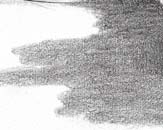Anatomy of Fear (6 page)

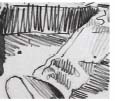
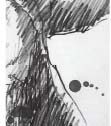
Russo was leaning in close, her perfume, something fresh and herbal, filling the air between us.
“My guess is that it is the same guy, and that he’s right-handed.” I knew this because I was right-handed and laid my strokes down in a similar way, but did not tell her because it was a bit creepy to think I had anything in common with whoever had made these drawings.
“Lab says they’re made with graphite.”
“Aka pencil. And a fairly soft one. Could be a standard number-two pencil, though probably softer, a three or four.” I gave her a little tutorial on pencils, hard versus soft, taking them out of my pencil box and displaying them as I did, ending with my personal favorite, the Ebony.
“Looks like a beaver chewed it,” she said.
“Bad habit,” I said, resisting an impulse to make a crude beaver joke, which I knew would not be appreciated.
“What else can you tell me about the drawings?”
I looked again. “I’d say he’s making them fast, and with a certain amount of assurance. He might have had some training, maybe art school, some drawing or design classes.”
Russo was listening intently, brows knit, a slight squint, like she was cataloging the information, maybe cataloging me too.
“The lab will no doubt be seeing if the paper is the same. And while they’re at it maybe you’ll get lucky and the guy will turn out to be a secretor and have left you a little DNA from sweaty palms.”
“Sounds like you’ve been hanging around the NYPD too long.”
“I went through the academy.”
“Really?”
“Yeah, but I chose forensic art over the street.”
“Didn’t want to get your hands dirty?”
“Just the opposite.” I tugged off the gloves and displayed my hands, the graphite and charcoal always there, no matter how many times I washed them, under the nail beds, and my slightly chewed cuticles.
“I didn’t mean that as an insult,” she said. “Unfortunately, prelims say there are no fluids—other than the two vics’ blood—on either drawing.” She looked directly at me. “Anything you can tell me about the unsub from the drawings themselves?”
She’d switched into cop lingo,
vic
for victim,
unsub
for unknown subject. On some level she had started treating me like a cop. I took it as a good sign.
“You mean like, does he hate his mother or torture animals?”
“Not quite, but—”
“I get your drift. Analyze the artist through his art.”
“Something like that.”
“Hope nobody ever does that about me.”
“Why? What would they find?”
“I don’t know…that I have an obsession with rapists and murderers because that’s all I ever draw?”
She arched a brow. “So what about this guy?”
I told her I wasn’t a psychiatrist, but from the look of the drawings I’d guess whoever made them was neat, compulsive, and very definite, the latter because I couldn’t detect any erasing. “It’s just my initial read, and it’s possible someone could make totally tight-ass drawings and be a mess in real life.” I knew that for a fact: My own drawings were even tighter than this guy’s and if anyone saw the mess in my apartment they’d never guess I could make them. “You might want to send them to Quantico for a psyche profile.”
“We’ve got it under control,” she said, but I could see she was bullshitting when she said it because the exact opposite flashed across her face.
People don’t realize our faces are controlled by a totally separate, involuntary system of muscle movements that reveal what we’re really feeling. They listen to what’s being said when they want the truth. Me, I watch what’s happening on the face.
Like right now, Russo was practicing what’s called neutralizing, trying to freeze her face. But there was something going on around her mouth, the first place to look for facial leakage, her orbicularis oris muscle being used for what is commonly referred to as lip sucking, a dead giveaway for anxiety. My guess was Terri Russo was worried that if she didn’t get something soon, the G, which is how the cops referred to the FBI, would be taking over the case.
“So why do you think this guy makes drawings of his vics?” she asked.
“Don’t know. The only thing that drawing his victims proves is that he’s stalked them, right? He’d have to, to be able to draw them.”
“Yes, but my question is why make them in the first place?”
“Could be his signature? Maybe he wants everyone to
know
it’s his work?”
Russo angled another look at me. Maybe she was thinking I was smarter than she’d expected, not just a drop-out cop with a flair for drawing who’d forgotten to shave.
“You should have been a shrink, Rodriguez.”
I told her that the shrink stuff had been part of my college and forensic art training, but didn’t bother to tell her that my mother was a psychiatric social worker and I’d grown up around it too. “No way,” I said. “I couldn’t take people complaining all day.”
She glanced from me to the drawings, then back at me. There
was something going on in her mind. I could see it from the dozens of fleeting micro-expressions that were passing over her face, none of them staying quite long enough for me to read.
“By the way, I owe you a thank-you,” she said. “I should have called about that sketch you made for my department, but I got busy, you know how it is.”
“Sure,” I said.
“It was an amazing resemblance. I knew the guy right away. How do you do it—I mean, capture that kind of likeness?”
“What can I say? I’m a trained professional.”
“No, seriously.”
“I don’t know. It’s something I could always do, draw from memory. I used to practice as a kid, do portraits of my friends when they weren’t around; athletes and movie stars too.” Something about her question made me start back on a cuticle.
“Right, but those are faces you’d be familiar with, that you’d seen. I mean, how can you draw someone you’ve
never
seen?”
“It’s mostly the training, but…sometimes, when I make a connection, things just come to me, and I see them.”
“Like what things?”
I glanced at my cuticle. It was bleeding. I shoved my hand into my pocket. “I don’t know, not exactly. It’s some sort of…transference.”
“What do you mean by that?”
“Like between a shrink and a patient—you know, the Freudian thing? But maybe that’s the wrong word. If you ask one of the geeks who use computer programs, the ones that move noses and lips around instead of pencil on paper, I don’t know what they’d say, but I’m guessing they’d think it was more science than intuition.”
“But you don’t think so?”
“I guess I’m just a dinosaur, but I like my pencils and paper, and
I like the time it takes to get acquainted with a subject, to hear what they’re saying, to look at them.” I looked at Terri Russo, her good bone structure, smooth skin across her frontal eminence, the beautifully arched brows over her supraorbital, the nice sharp angle of her mandible, and smiled.
“What’s so funny?”
“Nothing. Sometimes I forget I’m not working.”
“But you
are
working.” She raised her brow for a second. “So you can draw just about anything.”
“Is this a test?”
“You don’t have to get defensive, Rodriguez.”
“Nate.”
“Okay. Nate. It was just a question.”
“Yeah, I guess I can draw just about anything.”
“See,” she said. “That wasn’t so hard. I was asking because we haven’t yet come up with a witness to either of these murders, but if we do, you’d obviously be the man to call.”
I nodded.
“Right.” She glanced up, the muscles around her mouth pinching her lips. She was deciding whether or not to ask a question. “And…what if we never get a witness?”
“Excuse me?”
“I was just wondering if you might be able to make a sketch.”
“You mean without a witness?”
“Yes.”
“I’m not a psychic or a witch doctor.”
“No, of course not.” She scanned my face a moment, and once again I could see her weighing a question. “But what about the transference thing?”
“Well, yes, but I need someone to have it with.”
“Right,” she said. “Of course.”
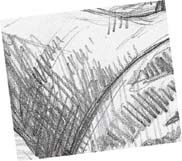
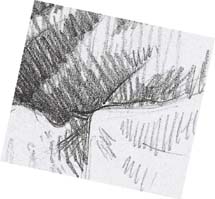
T
he images have begun to appear, just a few repeated fragments, but enough to record.
A new sheet of paper, a few more fragments drawn, but still they refuse to coalesce.
Relax.
A long deep breath, eyes closed, trying to imagine what he will do and how they will die. But still the images resist, fragments doing a jitterbug in and around his optic nerve, not quite ready to make the journey from brain to eye to paper.
He pushes away from the table with a hissing sigh, gazes at the pictures he has affixed to his walls for inspiration, and the fragments in his mind start up again.
The puzzle pieces have begun to take on meaning, each one adding to the whole: a stroke, a shape, an abstract blob, coming
together to tell him what he needs to know. He sets one against another, fleshing out the picture, time passing, more and more fragments committed to paper, the image finally harvested.
